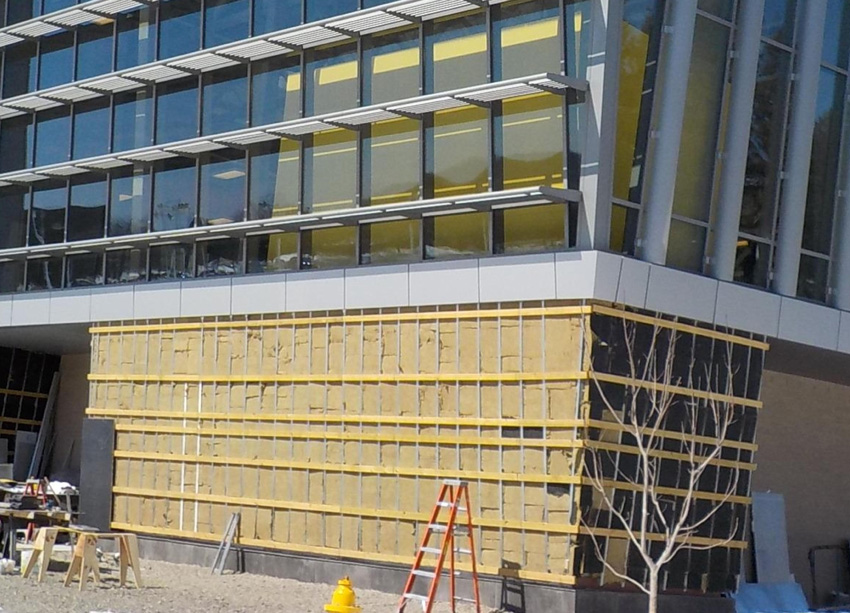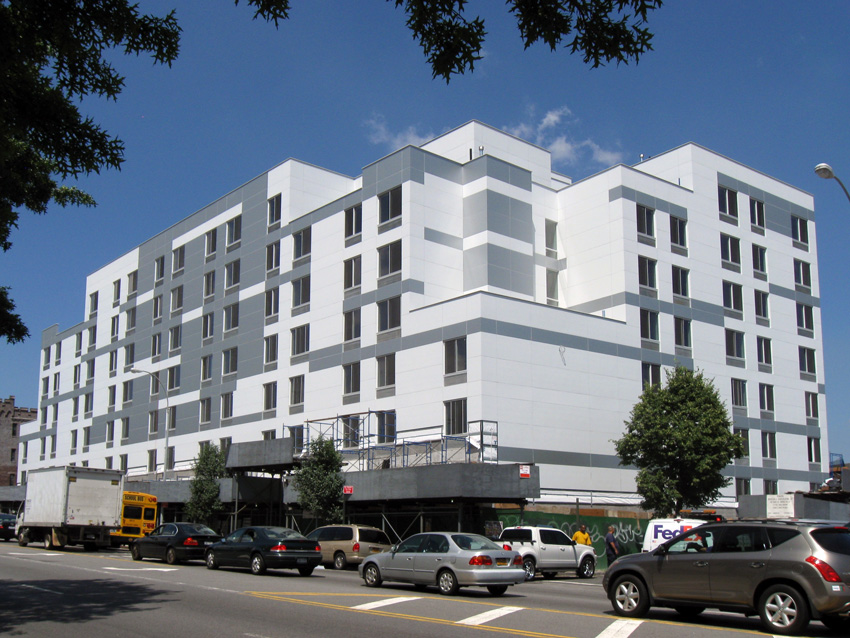Code-Compliance Conflicts in the Exterior Wall Assembly
3. Structural Requirements, Moisture Management, and Energy Code/Continuous Insulation
An exterior wall assembly must include structural support for the cladding that effectively manages moisture and enough continuous insulation to meet the requisite thermal performance, as prescribed by the building codes. Unfortunately, the two types of insulation most commonly used in the exterior wall assembly to achieve continuous insulation have their limitations in being able to manage water and adequately resist fire spread.
Stone Wool
Stone wool, also referred to as mineral wool or rockwool, is created by taking a mineral salt and spinning it so that it resembles cotton candy, which is then formed into blankets or boards for use as insulation. Because the matrix is a combination of mineral fibers and air, it resists heat flow efficiently.

Photo courtesy of Laminators Incorporated
This exterior wall system installed stone wool between vertical, cold-formed metal furring, with lumber furring installed horizontally across the face, and is designed to manage moisture behind the stone wool layer.
Unfortunately, because of its constitution, mineral wool has water management issues. It can absorb water, which impedes the exit of moisture from the exterior wall assembly, and exposes the wall cavity to all of the problems that can be caused by trapped moisture. Though it dries with sufficient ventilation, surface tension and capillarity will hold moisture against any surface in direct contact with the stone wool where it has become saturated. In order to design a compliant enclosure with mineral wool insulation, another layer of water control must be added into the assembly. But even this is trickier than it sounds because incorporating multiple vapor retarders and drainage planes into one wall assembly requires careful consideration and detailing.
Rigid Board Foam Plastic Insulation
Foam plastic insulation is available as rigid board in many different chemistries, and each offers a unique balance of cost, efficiency, and capabilities. Some forms of rigid foam insulation do not absorb or retain water and can be used simultaneously as a perfect vapor barrier and the air and water barrier. When detailed properly, it is a good choice for ensuring that the building enclosure allows any water that penetrates the exterior assembly to drain and evaporate out, while simultaneously incorporating continuous insulation. It is important to note that utilizing rigid foam insulation requires careful considerations regarding where the primary water control barrier will be, where the primary vapor control barrier will be, and the treatment of the rigid board joints. If the joints are not properly managed or a type of foam not rated to be an air and water barrier is used, the layer of rigid board insulation can cause moisture to be trapped behind it.
4. Structural Requirements, Moisture Management, Energy Code/Continuous Insulation, and Fire Requirements
As explored in this article, it is possible to achieve a structurally stable substrate with good moisture-managing capabilities and continuous insulation using some combination of a proprietary secondary framing system and rigid board insulation with the drainage plane that has been well-defined and detailed properly. Unfortunately, the introduction of rigid foam insulation into a wall assembly triggers the need to meet the requirements of NFPA 285. Even if rigid foam is not used, NFPA 285 compliance may still be required depending upon the cladding type, the geometry, and the specifics of the installation. Though a very specific combination of systems, materials, and installation methods can achieve the goal of an exterior wall assembly that can rectify all four of the code conflicts, there are very few that can be documented in a manner that demonstrate compliance to the satisfaction of code officials.

Photo courtesy of Laminators Incorporated
Specifying exterior wall systems that are NFPA 285 compliant often requires a proprietary specification that makes it difficult for the project to be competitively bid.
The problem exists because many designers need to keep a specification non-proprietary to encourage competitive bids and a wall assembly that is capable of rectifying the four conflicts is inherently proprietary. The proprietary nature of the NFPA 285 test is a function of the fact that it is an assembly test, not a component test, and it only exacerbates the situation. The NFPA 285 test evaluates the performance of an entire exterior wall assembly when it is fully burning and then deems the entire assembly, built from that specific combination of parts and pieces, as either being compliant or not compliant. Substitutions are not allowed.
In short, it is impossible to write a generic specification for an exterior wall assembly that is NFPA 285 compliant. In order to specify an NFPA 285-compliant assembly, a designer will need to specify an assembly that includes the specific make and model of the exact components that were tested and approved. Any substitution of the insulation, structural support, flashing, cladding, etc. in an assembly requires that it be tested again or, at the very least, will require an engineering judgment letter.
An engineering judgement letter is written by a fire professional or engineer who compares the theoretical performance of a proposed wall assembly to that of an assembly that is NFPA 285 compliant. This professional will incorporate data on the initial NFPA 285-compliant wall assembly and the proposed components to be added and evaluate whether or not the new assembly would be compliant if it were to be tested. Engineering judgement letters are written on a job-by-job basis and only for very specific assemblies. Please note that engineering judgement letters make it possible for designers to specify assemblies that have not yet been tested by NFPA 285 and still satisfy the fire control requirements of the building codes, but they do not make it possible to specify a non-proprietary or generic exterior wall assembly. The acceptance of an engineering judgement letter is at the discretion of the local authority having jurisdiction over the project and the local code official’s willingness to accept the professional’s conclusions.
After reading this article, it may be an understatement to say that specifying a code-compliant exterior wall assembly is complex. It requires that a designer navigate multiple codes and correctly integrate various stand-alone systems in a way that does not compromise the functionality of any individual system or the assembly as a whole. There are a number of potential pitfalls. Structural supports for the veneer of the assembly can impede moisture control or break the continuous insulation. The insulation may require additional air and water barriers or require that the assembly achieve NFPA 285 compliance. To overcome these challenges, it is likely that specifiers will have to collaborate with manufacturers, fire professionals, and local code officials to attain the necessary documentation to demonstrate code compliance.









